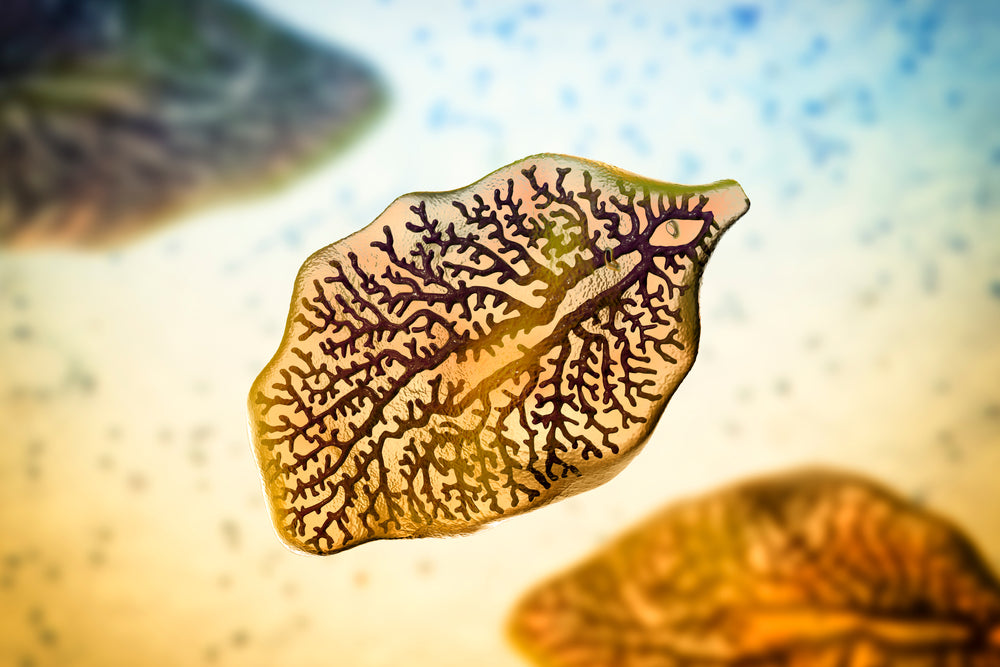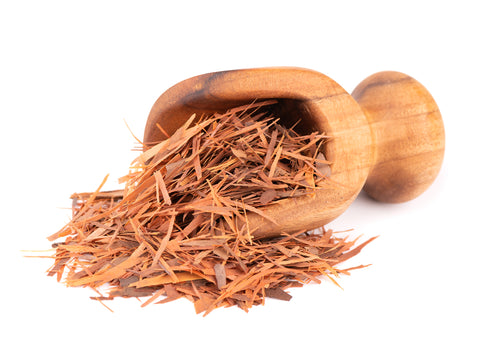What Are Liver Fluke Parasites?

Share
Liver flukes are a common type of parasitic worm that can infect the liver in humans and cause numerous health issues. Infections in humans usually occur after eating contaminated raw or undercooked freshwater fish or watercress. After liver flukes have been ingested, they travel from your intestines to your bile ducts in your liver where they then live and grow. In this article, we are going to cover everything you need to know about this parasite.
What Are Parasites?
Parasites are creatures that live on or in the body of a host organism and gets its food from or at the host’s expense. There are many different kinds of parasites. Parasites in humans live inside us and use up our vitamins, proteins and other nutrients, depriving us of optimal nutrition. Not only do they steal nutrients from our body, but they also eliminate waste inside us, releasing their toxic bacteria and viruses. Parasites are most commonly found in the intestines, however, any part of the body is vulnerable to infestation, including the lungs, liver, brain, blood, muscles, joints, skin, and other organs.
Parasites are an abundant and extremely underdiagnosed health condition that many people suffer from. There are hundreds of different types of parasites, and it is estimated that nearly half the world’s population has at least one type of parasite in them, if not more.
Parasites can be very damaging to our health, so it is important to educate yourself about parasites, how you may become infected, how you can prevent infection and avoid sources of contamination, and how you can treat a parasitic infection if you get one.
To learn more about the different types of parasites that can infect humans, read our blog "Most Common Types of Parasites."
What Are Flukes?

Flukes are leaf-shaped flatworms, commonly known as trematodes or trematoda. They are parasitic during nearly all of their life cycle forms. The cycle begins when larvae are released into fresh water by infected snails. The free-swimming larvae can then directly penetrate the skin of a human host or are ingested after encysting in or on various edible vegetation, fish, or crustaceans.
What Are Liver Flukes?
Liver flukes are a type of fluke that can infect humans and cause liver and bile duct disease. There are two families of liver flukes that cause disease in humans: Opisthorchiidae (which includes species of Clonorchis and Opisthorchis) and Fasciolidae (which includes species of Fasciola). These two families of liver flukes differ in their geographic distribution, life cycle, and long-term outcome after clinical infection.
Clonorchis is a liver fluke parasite that can infect humans. Humans get liver fluke parasites by eating raw or undercooked fish, crabs, or crayfish from areas where the parasite is found. Common in Asia and Hawaii, Clonorchis is also known as the Chinese or oriental liver fluke. Liver flukes infect the liver, gallbladder, and bile duct in humans, causing the liver to become enlarged and tender. It also causes inflammation, chills, fever, jaundice and a type of hepatitis.
While most infected people do not show any noticeable symptoms, infections that last a long time can result in severe symptoms and serious illness. Untreated, infections may even persist for up to 25–30 years, the lifespan of the parasite.
The Opisthorchis species of liver flukes are liver fluke parasites that humans can get by eating raw or undercooked fish, crabs, or crayfish from areas in Asia and Europe where the parasite is found, including Thailand, Laos, Cambodia, Vietnam, Germany, Italy, Belarus, Russia, Kazakhstan, and Ukraine. Typical symptoms of this liver fluke include indigestion, abdominal pain, diarrhea, or constipation.
Fascioliasis is a parasitic infection typically caused by Fasciola hepatica, which is also known as “the common liver fluke” or “the sheep liver fluke.” A related parasite, Fasciola gigantica, also can infect people.
The common liver fluke is found in all continents except Antarctica, in over 70 countries, especially where there are sheep or cattle. People usually become infected by eating raw watercress or other water plants contaminated with immature parasite larvae. The young worms move through the intestinal wall, the abdominal cavity, and the liver tissue, into the bile ducts, where they develop into mature adult flukes that produce eggs. The pathology typically is most pronounced in the bile ducts and liver.
What Are Symptoms of Liver Flukes?
The symptoms of liver flukes differ slightly depending on the exact type of liver fluke parasite that caused the infection. In general, common symptoms of infection include:
- Enlarged liver
- Eosinophilia (higher than normal levels of eosinophils, a type of white blood cell)
- Itching
- Fever
- Chills
- Nausea
- Vomiting
- Abdominal discomfort or pain
- Diarrhea
- Hives
- Malaise
- Decreased appetite
- Weight loss
There are also some rare complications associated with heavy liver fluke infections, including stone formation, recurrent infections of the biliary system, and cholangiocarcinoma. It is also very common for people infected with liver flukes to show no symptoms. However, if untreated, these parasites can begin to cause complications and health issues.
The Life Cycle of Liver Flukes
- Immature eggs are discharged in the biliary ducts and passed in the stool
- Eggs become embryonated in freshwater over 2 weeks
- Embryonated eggs release miracidia, which invade a suitable snail intermediate host.
- In the snail, the parasites undergo several developmental stages and are then released from the snail at the stage known as cercariae and encyst as metacercariae on aquatic vegetation or other substrates.
- Humans and other mammals become infected by ingesting metacercariae-contaminated vegetation (such as watercress) or eating infected fish.
- After ingestion, the metacercariae excyst in the duodenum and penetrate through the intestinal wall into the peritoneal cavity.
- The immature flukes then migrate through the liver parenchyma into biliary ducts, where they mature into adult flukes and produce eggs.
- In humans, maturation from metacercariae into adult flukes usually takes about 3–4 months.
- Adult liver fluke parasites settle in the small bile ducts and can live there for 20 to 30 years. The long-lived flukes can cause long-lasting chronic inflammation of the bile ducts, which often leads to further problems.
- Four to six months after they settle in the bile ducts, the adult flukes start producing eggs, which are then passed out into the intestines.
Other Types of Flukes
Other common types of flukes that infect humans include:
- Blood fluke (Schistosoma japonicum, Schistosoma mansoni, Schistosoma haematobium)
- Oriental lung fluke (Paragonimus westermani)
- Intestinal fluke (Fasciolopsis buski)
How Do You Get Rid of Liver Flukes?
Eliminating parasites of any kind can be difficult, and it depends on what type of parasite one is infected with, as well as how severe the infection is. That being said, there are effective ways to eliminate a wide range of parasites, and some methods for doing so are time-tested and have been used traditionally for thousands of years.†
One traditional method of detoxing parasites from the body, and one that has had much modern scientific research to back it, is the use of a well-crafted wormwood complex.† Wormwood complex is the name given to a formula for killing parasites that contains three essential herbs: wormwood, clove, and green black walnut hulls. Together, these anti-parasitic herbs kill the larvae, egg, and adult stages of parasites, and when used alongside a parasite detox protocol and a healthy diet, can help to kill the entire life cycle of a parasite, ensuring that one effectively kills the organism(s) and prevents reinfection.† Make sure to read about the die off side effects of cleansing parasites before doing a parasite cleanse so you can mitigate the symptoms of parasitic die off.
When it comes to liver flukes, consider also taking specific herbs that target parasites in the liver. Pau d’arco, featured in our Liver Detox & Support Tonic, is a particularly effective herb for killing liver flukes, as it contains the naphthoquinones lapachol and beta-lapachone which help to kill bacteria, fungi, viruses, and parasites, including liver flukes.

Supplementing with Probiotics
When suffering from a parasitic infection of any kind it is also recommended to supplement with a high quality multi-strain probiotic complex—especially if you are doing a parasite cleanse. Make sure the formula contains clinically studied , strains, is shelf stable, and contains an enteric coating. When cleansing harmful organisms in your gut, you may incidentally get rid of some of the good bacteria as well. Supplementing with a Multi-Strain Probiotic Complex can help you replenish your gut bacteria and keep your microbiome in balance. It is incredibly important for gut health to restore the optimal balance of bacteria in the gut, and a multi-strain probiotic is one of the best ways to do this.
Summary
Liver flukes are a common type of parasitic worm that can infect the liver in humans and cause numerous health issues. Infections in humans usually occur after eating contaminated raw or undercooked freshwater fish or contaminated vegetables like watercress.
After liver flukes have been ingested, they travel from your intestines to your bile ducts in your liver where they then live and grow. If untreated, liver flukes can live inside of a human host for up to 30 years. Long term liver fluke infections may cause long-lasting chronic inflammation of the bile ducts, which often leads to further problems.
For this reason, it is very important to clear a liver fluke infection if you get one. The issue is, even people that show no symptoms can suffer from a liver fluke infection. It is recommended to do a parasite cleanse a few times each year as a precautionary measure to protect against parasitic infections, not just of liver flukes, but of the over 100 different types of parasites that may affect us.
While parasites may be an uncomfortable reality to consider, they are a very prevalent health issue, and the more educated you are about them, the better position you are in to take control of your own health.
References:
https://www.ncbi.nlm.nih.gov/books/NBK1899/
https://www.ncbi.nlm.nih.gov/books/NBK8262/
https://www.cdc.gov/parasites/index.html
https://www.cdc.gov/parasites/liver_flukes/index.html
https://www.ncbi.nlm.nih.gov/books/NBK537032/